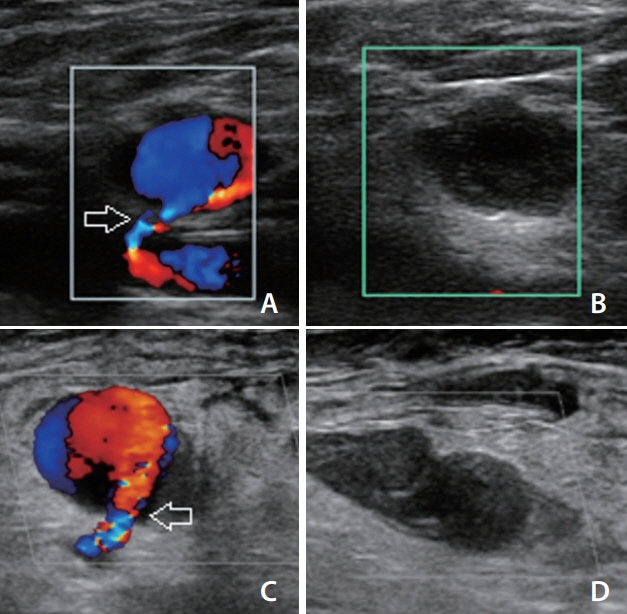Neurointervention.
2020 Mar;15(1):25-30. 10.5469/neuroint.2019.00206.
Safety and Effectiveness of Percutaneous Low-Dose Thrombin Injection for Femoral Puncture Site Pseudoaneurysms in Neurointervention: Single-Center Experience
- Affiliations
-
- 1Department of Radiology, Research Institute of Radiology, Asan Medical Center, University of Ulsan College of Medicine, Seoul, Korea
- KMID: 2502079
- DOI: http://doi.org/10.5469/neuroint.2019.00206
Abstract
- Purpose
We present ultrasound-guided percutaneous low-dose thrombin (200–250 IU) injection for the treatment of iatrogenic femoral pseudoaneurysms. Second, we compared patient and procedure factors between subcutaneous hematoma and pseudoaneurysm groups.
Materials and Methods
From April 2012 to May 2018, 8425 patients underwent neurointervention. Among these patients, 18 had small subcutaneous hematomas and 6 had pseudoaneurysms. Pseudoaneurysms in the neck and entire sac were visualized, and low-dose thrombins were injected while visualizing a “whirlpool” hyperechoic core in the pseudoaneurysm sac. Subcutaneous hematomas were treated with simple compression. We compared the following parameters between the subcutaneous hematoma group and pseudoaneurysm group: sex, age, body mass index (BMI), type of procedure, heparin usage, sheath size, procedure time, and number of previous neurointervention procedures with the Mann-Whitney U test.
Results
Most of the pseudoaneurysms were successfully occluded with 200 IU of thrombin (n=5). Only 1 pseudoaneurysm required a slightly higher thrombin concentration (250 IU, n=1). During the short-term follow-up, no residual sac was observed and no surgical repair was necessary. Pain in the groin region was alleviated. During the 1-month follow-up, no evidence of pseudoaneurysm recurrence nor subcutaneous hematoma was noted. Patient factors (sex, age, and BMI) and procedure factors (heparin usage, sheath size, procedure time, number of previous procedures) were not statistically different between the subcutaneous hematoma and pseudoaneurysm groups.
Conclusion
Ultrasound-guided percutaneous low-dose thrombin injection (200–250 IU) is safe, effective, and less invasive for treating iatrogenic femoral pseudoaneurysm in neurointervention.
Figure
Reference
-
1. Ates M, Sahin S, Konuralp C, Gullu U, Cimen S, Kizilay M, et al. Evaluation of risk factors associated with femoral pseudoaneurysms after cardiac catheterization. J Vasc Surg. 2006; 43:520–524.
Article2. Dudeck O, Teichgraeber U, Podrabsky P, Lopez Haenninen E, Soerensen R, Ricke J. A randomized trial assessing the value of ultrasound-guided puncture of the femoral artery for interventional investigations. Int J Cardiovasc Imaging. 2004; 20:363–368.
Article3. Grewe PH, Mügge A, Germing A, Harrer E, Baberg H, Hanefeld C, et al. Occlusion of pseudoaneurysms using human or bovine thrombin using contrast-enhanced ultrasound guidance. Am J Cardiol. 2004; 93:1540–1542.
Article4. Gürel K, Gür S, Özkan U, Tekbaş G, Önder H, Oğuzkurt L. US-guided percutaneous thrombin injection of postcatheterization pseudoaneurysms. Diagn Interv Radiol. 2012; 18:319–325.5. Heis HA, Bani-Hani KE, Elheis MA, Yaghan RJ, Bani-Hani BK. Postcatheterization femoral artery pseudoaneurysms: therapeutic options. A case-controlled study. Int J Surg. 2008; 6:214–219.
Article6. Illescas MEB, Ruiz AP, Rodríguez MLR, Pardo LC, de la Cruz RQ. Femoral artery pseudoaneurysms. Treatment with thrombin, but ¿always? ECR 2015 Scientific Exhibit. 2015.7. Krueger K, Zaehringer M, Strohe D, Stuetzer H, Boecker J, Lackner K. Postcatheterization Pseudoaneurysm: results of US-guided percutaneous thrombin injection in 240 patients. Radiology. 2005; 236:1104–1110.
Article8. Kassem HH, Elmahdy MF, Ewis EB, Mahdy SG. Incidence and predictors of post-catheterization femoral artery pseudoaneurysms. Egypt Heart J. 2013; 65:213–221.
Article9. Knight CG, Healy DA, Thomas RL. Femoral artery pseudoaneurysms: risk factors, prevalence, and treatment options. Ann Vasc Surg. 2003; 17:503–508.
Article10. La Perna L, Olin JW, Goines D, Childs MB, Ouriel K. Ultrasound-guided thrombin injection for the treatment of postcatheterization pseudoaneurysms. Circulation. 2000; 102:2391–2395.
Article11. Tuna Katırcıbaşı M, Güneş H, Çağrı Aykan A, Aksu E, Özgül S. Comparison of ultrasound guidance and conventional method for common femoral artery cannulation: a prospective study of 939 patients. Acta Cardiol Sin. 2018; 34:394–398.12. Mishra A, Rao A, Pimpalwar Y. Ultrasound guided percutaneous injection of thrombin: effective technique for treatment of iatrogenic femoral pseudoaneurysms. J Clin Diagn Res. 2017; 11:TC04–TC06.
Article13. Stone PA, AbuRahma AF, Flaherty SK, Bates MC. Femoral pseudoaneurysms. Vasc Endovascular Surg. 2006; 40:109–117.
Article14. Paulson EK, Nelson RC, Mayes CE, Sheafor DH, Sketch MH Jr, Kliewer MA. Sonographically guided thrombin injection of iatrogenic femoral pseudoaneurysms: further experience of a single institution. AJR Am J Roentgenol. 2001; 177:309–316.15. Pinton FA, Spósito AR, Vahle VDA, Soares PR, Zalc S, Perin MA, et al. Ultrasound-guided thrombin injection in the treatment of femoral artery pseudoaneurysm after percutaneous procedures in patients with acute coronary syndrome. Rev Bras Cardiol Invasiva. 2013; 21:18–22.
Article16. Schneider C, Malisius R, Küchler R, Lampe F, Krause K, Bahlmann E, et al. A prospective study on ultrasound-guided percutaneous thrombin injection for treatment of iatrogenic post-catheterisation femoral pseudoaneurysms. Int J Cardiol. 2009; 131:356–361.
Article17. Vlachou PA, Karkos CD, Bains S, McCarthy MJ, Fishwick G, Bolia A. Percutaneous ultrasound-guided thrombin injection for the treatment of iatrogenic femoral artery pseudoaneurysms. Eur J Radiol. 2011; 77:172–174.
Article18. Reeder SB, Widlus DM, Lazinger M. Low-dose thrombin injection to treat iatrogenic femoral artery pseudoaneurysms. AJR Am J Roentgenol. 2001; 177:595–598.
Article19. Stone PA, Campbell JE, AbuRahma AF. Femoral pseudoaneurysms after percutaneous access. J Vasc Surg. 2014; 60:1359–1366.
Article20. Yoo T, Starr JE, Go MR, Vaccaro PS, Satiani B, Haurani MJ. Ultrasound-guided thrombin injection is a safe and effective treatment for femoral artery pseudoaneurysm in the morbidly obese. Vasc Endovascular Surg. 2017; 51:368–372.
Article
- Full Text Links
- Actions
-
Cited
- CITED
-
- Close
- Share
- Similar articles
-
- Ultrasound-Guided Percutaneous Thrombin Injection of Femoral Artery Pseudoaneurysms Caused by Vascular Access
- Percutaneous Thrombin Injection for the Treatment of Post-Procedural Iatrogenic Pseudoaneurysms
- Percutaneous Ultrasound-Guided Thrombin Injection in Iatrogenic Arterial Pseudoaneurysms: Effectiveness and Complications
- Percutaneous ultrasound-guided thrombin injection is effective even in infants with external iliac artery pseudoaneurysms
- Percutaneous Thrombin Injection with Balloon Occlusion for the Treatment of a Femoral Artery Pseudoaneurysm



